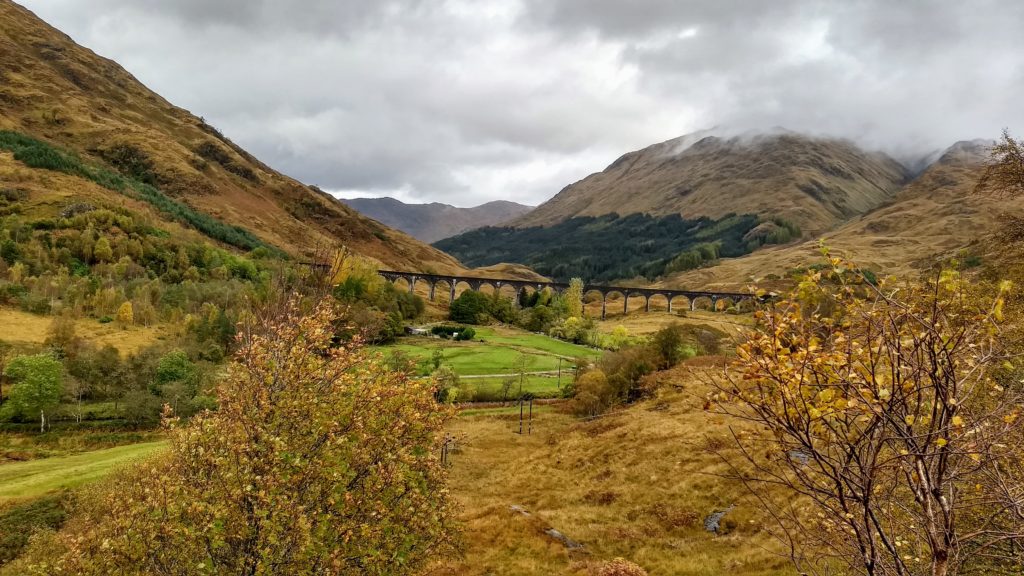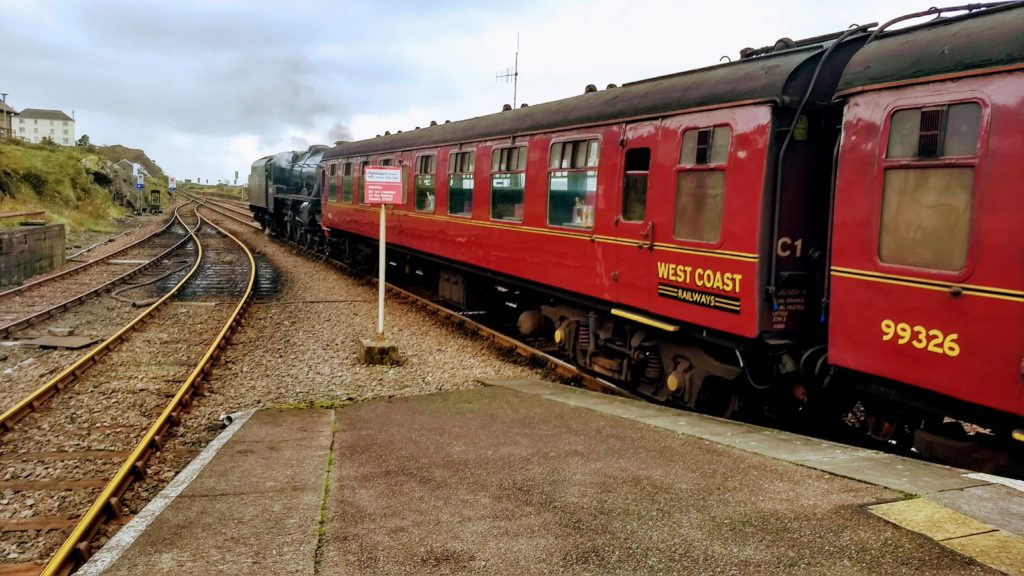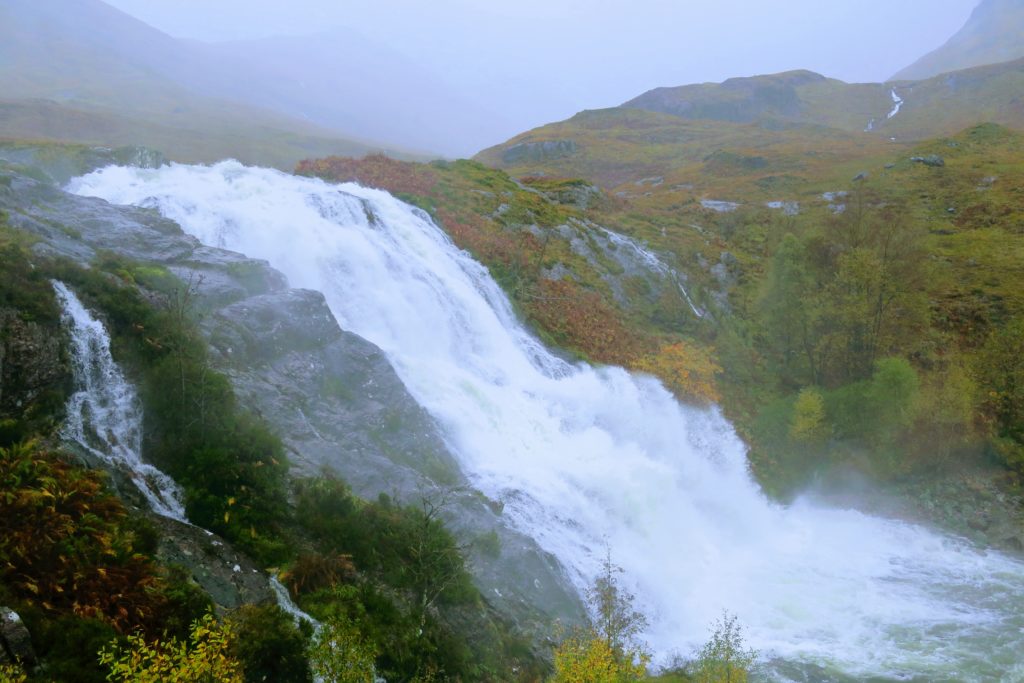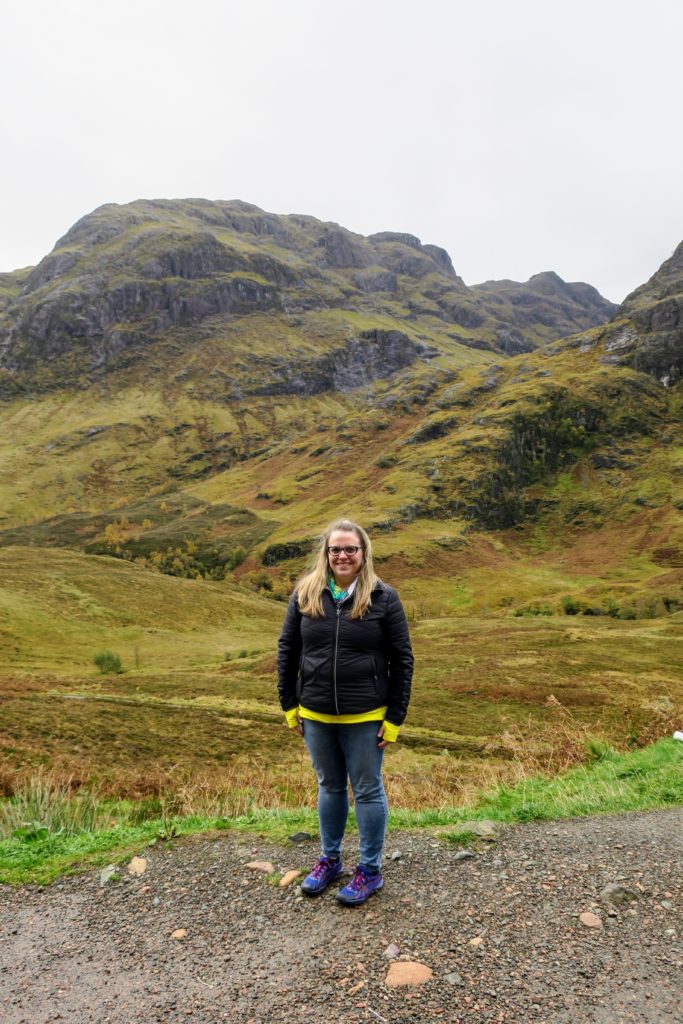Day:33 Km travelled: 500km Steps: 10,276
October 12th, 2017
The Scottish Highlands have so much to offer that its impossible to take it all in with only 1 day. Therefore, my second day in the place of the Gaels was spent exploring the western coast.
GLENFINNAN
Located midway between the towns of Mallaig & Fort William ( a la ‘Outlander’ fame), Glenfinnan was the site where, in 1745, Bonnie Prince Charlie raised his standard and thus commenced the Jacobite Rising (or Rebellion depending on which side you were on) of forty-five. A 60 foot memorial stands in that spot to commemorate the event. One cannot escape references to this rebellion when in The Highlands. Who exactly was this ‘Bonnie Prince’ & his Jacobites? This bit of Scottish history is complex and I will try to keep it as simple as possible.
 In 1688, the widely unpopular Catholic King James VII of Scotland (James II of England) was deposed in what is now called the Glorious Revolution. His daughter Mary & her husband William of Orange assumed the throne, establishing a long line of Protestant British Monarchs that endure even today. Mary died childless however and plunged the Empire into chaos. As per the new law, the monarch was required to be Protestant, therefore the crown passed more senior members of the royal family and the House of Hanover assumed power. Many Highlanders, however, continued to support the exiled Stuart King and felt that his Catholic descendants were the rightful heirs. The word Jacobite means literally ‘follower of James’ and thus a movement was born.
In 1688, the widely unpopular Catholic King James VII of Scotland (James II of England) was deposed in what is now called the Glorious Revolution. His daughter Mary & her husband William of Orange assumed the throne, establishing a long line of Protestant British Monarchs that endure even today. Mary died childless however and plunged the Empire into chaos. As per the new law, the monarch was required to be Protestant, therefore the crown passed more senior members of the royal family and the House of Hanover assumed power. Many Highlanders, however, continued to support the exiled Stuart King and felt that his Catholic descendants were the rightful heirs. The word Jacobite means literally ‘follower of James’ and thus a movement was born.
In 1745, James’ grandson, Charles Edward Stuart (Bonnie Prince Charlie to the Scots, The Young Pretender to the English) rallied Highlanders to the cause and a series of bloody battles and uprisings followed. Ultimately, the Jacobites suffered a swift and crushing defeat at The Battle of Culloden where almost 2000 Scottish solders were killed.

Located opposite of the memorial, is the now famous Glenfinnan Viaduct, known the world over. Don’t recognize it? What if I give you a hint? Hogwarts Express. Sounds familiar now? The viaduct and the Jacobite Steam Train (more on that later) were used in the filming of the Harry Potter films. Potterheads from all over now converge on this tiny town en mass (the series has effectively saved the town’s economy). Long before the success of Outlander, Scotland was on the map for movie buffs as an ideal destination for Harry Potter fanatics since many scenes were filmed in the country and specifically in The Highlands.
No trip to this part of the country is complete without a ride on the Jacobite Steam Train.


The locomotive takes visitors on a scenic journey between Mallaig & Fort William. Many visitors, however, are not obsessed with trains like Sheldon and book a ticket for a very different reason. The steam train was used as the Hogwarts Express in several scenes throughout the movies. Passengers lucky enough to have a seat on the right side of the train press their noses to the windows (or better yet, press their smartphones to the windows) to spot the exact moment when the train passes over the Viaduct in an effort to capture the perfect shot. The Harry Potter theme is taken one step further as the train company even provides a special menu for fans.
Anything off the trolley dear?
GLENCOE
This is perhaps the most beautiful area of The Highlands. Hauntingly beautiful as it was also the site of a horrific massacre.
Following the Jacobite Rising and several other failed rebellions, King William III demanded that all clan chieftains sign an Oath of Allegiance before the 1st of January 1692. The chief of clan MacDonald refused however with only a few weeks remaining, he was convinced to do so by his sons. They set off for Fort William however due to poor winter conditions, the journey took longer then expected. They arrived on December 30th however were informed by the Governor that he was not authorized to accept it. The MacDonald clan was provided with a letter confirming that they had indeed arrived prior to the deadline and were sent to Inverary to sign the Oath. This was done on January 6th and the clan returned home, relieved.

In February of 1692, a British regiment was in the area and required lodging. There is something called Highland Hospitality which means that friends, family and even strangers would be welcomed and housed in highland homes. Food, shelter and protection would be willingly offered. For two weeks the soldiers lived alongside of the members of the MacDonald clan. On February 12 1692, they received orders to kill every single member of the clan, including men, women and children. They were to leave none alive as the King or his advisors wished to make an example of the MacDonalds for failing to sign the oath in the allotted time period. Many soldiers were horrified at the thought of killing their gracious hosts however, in the early morning of February 13th, the massacre took place. 38 members of the clan were murdered that morning and another 40 who had managed to escape perished in the harsh Highland winter. The Glen was never re-settled. The name Glencoe, in Gaelic, means ‘valley of tears’.

At the entrance to the valley there’s a waterfall called McDonald’s Tears, which is a kind of monument of this tragic day. The advantage of visiting during a downpour is the excess of water resulted in a roaring and abundant waterfall.

Further along the Glen, we came upon the most picturesque spots. There are only two houses that remain in the valley (no new ones are permitted to be built) and this one sits in a splendid location, feet away from a tiny bridge, a flowing river and mountains dotted with waterfalls. The spot is so scenic that it was chosen as the location of the Harry Potter movie scene where Hermione punches Malfoy (see? You can’t escape the HP movie tie-ins).


” Wherever I wander,
Wherever I rove,
The hills of The Highlands
Forever I love. “
∼ Robert Burns

Have enjoyed your blog, forwarded to me by Suzanne, a friend from high school. Further to your history of Glencoe. Most of those soldiers who murdered the clan MacDonald were Campbell’s. If you are in the company of elders from these clans at gatherings in Canada you will often hear them apologize for the event even tho it has been 300 plus years. Joanne MacDonald